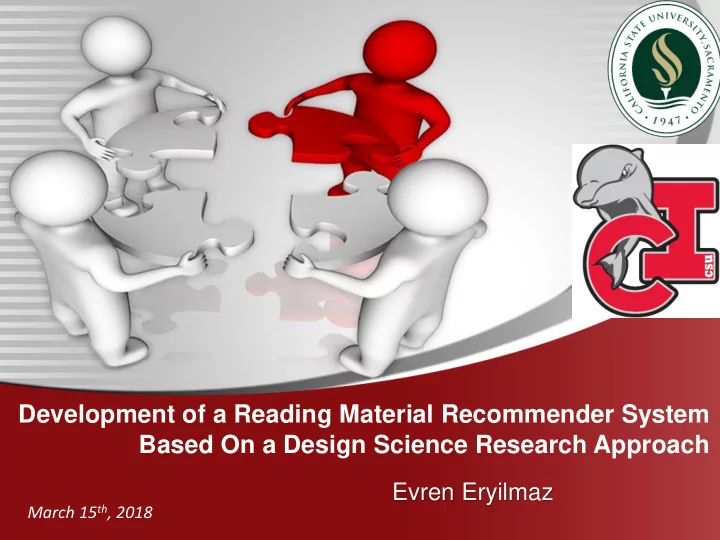

Development of a Reading Material Recommender System Based On a Design Science Research Approach Evren Eryilmaz March 15 th , 2018
Overview • Motivation and problem identification • Objective of my software • Design and development • Demonstration • Evaluation • Communication • Comments & questions
Motivation • Collaboration between software developers and business users can be instrumental to the success of software development projects. • Effective collaboration is an important interpersonal skills for an entry-level software developer’ professional growth within an organization (Aasheim et al., 2009). • Asynchronous online discussion can facilitate a natural setting for collaboration in virtual teams. Aasheim, C. L., Li, L., & Williams, S. (2009). Knowledge and skill requirements for entry-level information technology workers: A comparison of industry and academia. Journal of Information Systems Education , 20 (3), 349-356.
Problem Identification Many students perceive online discussions more confusing compared to face-to-face discussions because • They feel being overwhelmed by a large number of messages Peters, V. L., & Hewitt, J. (2010). An investigation of student practices in asynchronous computer conferencing courses. Computers & Education , 54 (4), 951-961.
Objective of my software • Draw asynchronous online discussion participants’ attention to the most important parts of overwhelmingly large discussions. Qiu, M., & McDougall, D. (2015). Influence of group configuration on online discourse reading. Computers & Education , 87 , 151-165.
Design Degree of Add Add Common Extract ground Extract A recommendation functionality with high predictive accuracy and perceived usefulness
Design • Collaborative Filtering • Content-based Filtering • Knowledge-based filtering • Hybrid approaches Abel, F., Bittencourt, I. I., Costa, E., Henze, N., Krause, D., & Vassileva, J. (2010). Recommendations in online discussion forums for e-learning systems. IEEE transactions on learning technologies , 3 (2), 165-176.
Design 1. Students ’ interests change over time depending on their level of understanding of a subject 2. The system needs to generate precise recommendations with a small amount of input
Development Cosine Similarity a,b : students r a,p : rating of student a for message p
Development Pearson Correlation Coefficient a,b : students r a,p : rating of student a for message p I : set of messages, rated both by a and b
Development Constrained Pearson Correlation Coefficient
Development Schafer, J. B., Frankowski, D., Herlocker, J., & Sen, S. (2007). Collaborative filtering recommender systems. In The adaptive web (pp. 291-324). Springer, Berlin, Heidelberg.
Development Eryilmaz, E. & Thoms, B., & Canelon, J. (Accepted). How Design Science Research Helps Improving Learning Efficiency in Online Conversations. Communications of the Association of Information Systems.
Development
Demonstration • Experiment 1: Is there any difference in the predictive accuracy and perceived usefulness of the developed recommendation functionalities?
Evaluation-Predictive Accuracy Recommendation Root Mean Squared Error Functionality Cosine Similarity 1.73 Pearson Correlation Coefficient 1.21 Constrained Pearson 0.87 Correlation Coefficient
Evaluation-Perceived Usefulness Q1: The recommendations were exactly what I was looking for Recommendation Average Standard Deviation Functionality Cosine Similarity 3.62 0.78 Pearson Correlation 4.06 0.60 Coefficient Constrained Pearson 4.44 0.61 Correlation Coefficient F(2,99) = 12.90, p <0.001***
Evaluation-Perceived Usefulness Q1: The recommendations were exactly what I was looking for Comparison pair Tukey HSD Tukey HSD Q statistic p-value Cosine Similarity vs Pearson Correlation 3.85 0.02* Coefficient Cosine Similarity vs Constrained 3.33 0.05* Pearson Correlation Coefficient Pearson Correlation Coefficient vs 7.18 0.001** Constrained Pearson Correlation Coefficient
Evaluation-Perceived Usefulness Q2: I was surprised by the recommendations Recommendation Average Standard Deviation Functionality Cosine Similarity 4.09 0.65 Pearson Correlation 4.23 0.67 Coefficient Constrained Pearson 4.35 0.64 Correlation Coefficient F(2,99) = 1.39, p =0.25
Evaluation-Perceived Usefulness Q3: The recommendations helped me to read instructional materials more effectively Recommendation Average Standard Deviation Functionality Cosine Similarity 4.15 0.68 Pearson Correlation 4.29 0.70 Coefficient Constrained Pearson 4.38 0.55 Correlation Coefficient F(2,99) = 1.15, p =0.32
Evaluation-Perceived Usefulness Q4: The recommendations prompted me to read postings on the forum Recommendation Average Standard Deviation Functionality Cosine Similarity 4.15 0.71 Pearson Correlation 4.29 0.82 Coefficient Constrained Pearson 4.38 0.61 Correlation Coefficient F(2,99) = 11.82, p <0.001***
Evaluation-Perceived Usefulness Q4: The recommendations prompted me to read postings on the forum Comparison pair Tukey HSD Tukey HSD Q statistic p-value Cosine Similarity vs Pearson Correlation 3.56 0.04* Coefficient Cosine Similarity vs Constrained 6.88 0.001** Pearson Correlation Coefficient Pearson Correlation Coefficient vs 3.32 0.05* Constrained Pearson Correlation Coefficient
Evaluation-Perceived Usefulness Q5: The recommendations prompted me to write on the forum Recommendation Average Standard Deviation Functionality Cosine Similarity 3.89 0.76 Pearson Correlation 4.09 0.51 Coefficient Constrained Pearson 4.25 0.45 Correlation Coefficient F(2,99) = 3.53, p =0.03*
Evaluation-Perceived Usefulness Q5: The recommendations prompted me to write on the forum Comparison pair Tukey HSD Tukey HSD Q statistic p-value Cosine Similarity vs Pearson Correlation 2.02 0.33 Coefficient Cosine Similarity vs Constrained 3.76 0.02* Pearson Correlation Coefficient Pearson Correlation Coefficient vs 1.73 0.44 Constrained Pearson Correlation Coefficient
Evaluation-Conversation Overload Coping Strategies Q1: In an average week, what percentage of the week’s messages do you read? Control Constrained Software Pearson Correlation Coefficient X 2 Choices % % P 0-20% 0.15 0.09 0.56 0.45 21-40% 0.35 0.12 5.23 0.02* 41-60% 0.32 0.12 4.19 0.04* 61-80% 0.15 0.5 9.68 0.002** 81-100% 0.03 0.18 3.99 0.05*
Communication Online Conversations Active and Meaningful Processing of Instructional Materials Users’ Limited Effort Coping Conversation Overload Interaction Environment Interaction Cost
Thank You for Your Time Your Comments and Questions are welcomed. Have a great spring break!
Recommend
More recommend